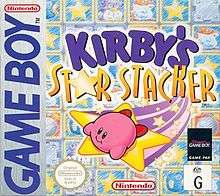Kirby's Star Stacker
Kirby's Star Stacker[lower-alpha 1] is a 1997 puzzle video game developed by HAL Laboratory for the Game Boy.
| Kirby's Star Stacker | |
|---|---|
 Game Boy cover | |
| Developer(s) | HAL Laboratory |
| Publisher(s) | Nintendo |
| Director(s) | Hitoshi Yamagami |
| Producer(s) | Hiroaki Suga |
| Composer(s) | Jun Ishikawa Hirokazu Ando |
| Series | Kirby |
| Platform(s) | Game Boy, Super Famicom |
| Release | Game Boy
Wii (Super Famicom)
|
| Genre(s) | Puzzle |
| Mode(s) | Single-player, multiplayer |
It received a remake for the Super Famicom in Japan.
Gameplay
Kirby's Star Stacker is similar in many respects to other puzzle games that were around at the time of its release, most notably, Dr. Mario and Tetris. The goal of the game is to earn as many stars possible by matching pairs blocks, (also referred to as friends in-game) that fall from the top of the play area. There are three types of blocks, all based on Kirby's friends from Kirby's Dream Land 2: Rick the hamster, Coo the owl, and Kine the fish. Stars are scored by sandwiching the stars between two matching blocks. When stars are scored, they disappear from the play area along with the pair of blocks enclosing them. The game is lost when the falling blocks reach the top of the play area (middle rows only), so it is critical to eliminate as many blocks as possible by scoring stars.
Gameplay modes
There are four game modes in Star Stacker.
- Round Clear - this is the main game, split into five difficulty modes (Normal, Hard, Very Hard, Super Hard, and Insane), each with a certain number of rounds. Rounds are cleared by eliminating a set number of stars. Each stage takes on a theme, such as a forest or outer space. When each round is cleared, the player is rewarded with special artwork using the themes of each stage.
- VS - the multiplayer mode, which only requires one cartridge of the game.
- Challenge - an endless mode. The object is to eliminate as many stars as possible before the stack of blocks reaches the top of the screen; a hand raises up the set of blocks, introducing a new row. Like Round Clear, in-game artwork is awarded depending on the number of stars collected, often encouraging the player to try harder next time (until the final picture is received).
- Time Attack - eliminate as many stars as possible in three minutes.
There is a high score table for the Challenge and Time Attack modes, showing the top three scores for each mode.
Kirby no Kirakira Kizzu
Kirby no Kirakira Kizzu (カービィのきらきら きっず - Kirby's Sparkling Kids), also commonly referred to as Kirby's Super Star Stacker, is a video game released in 1998 for the Super Famicom; ROMs for the game were distributed via the Nintendo Power flash RAM service, before the game was given a standard cartridge release a year later. Kirby no Kirakira Kizzu is an SNES remake of Kirby's Star Stacker with nearly identical gameplay. The point of the game is to remove falling star blocks by placing matching animal friends (Rick, Coo, and Kine) at either end. One of the primary enhancements is story mode, in which Kirby faces several opponents from other Kirby games (mostly from Kirby Super Star). The game's title is exactly the same as the Japanese title of the Game Boy version of Kirby's Star Stacker. There were plans to release the game overseas, but they were halted after Nintendo of America stopped shipping SNES games in 1997, leaving the game Japan-exclusive.
This version was released on the Wii Virtual Console in Japan on January 5, 2010.
Notes
- Known in Japan as Kirby's Sparkling Kids (カービィのきらきらきっず, Kābī no Kirakira Kizzu)
References
- "Kirby's Star Stacker Release Information for Game Boy". GameFAQs. Archived from the original on 2011-05-26. Retrieved 2011-02-25.
- http://www.nintendo.co.uk/NOE/en_GB/games/nintendo_3ds_virtual_console/kirbys_star_stacker_54742.html